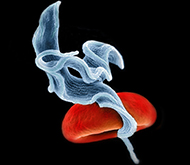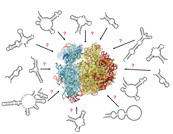Projects |
The regulatory non-coding RNA interactome of translating ribosomes
While the list of validated ncRNAs that regulate crucial cellular processes (e.g. chromatin modulation; mRNA turnover; etc) grows steadily, not a single regulatory ncRNA has been identified (with the notable exception of signal recognition particle RNA) that directly interacts with and regulates the ribosome during translation. All of the recently discovered ncRNAs that regulate protein synthesis (e.g. micro RNAs, siRNAs, anti-sense RNAs) target the mRNA rather than the ribosome. This is unexpected, given the central position the ribosome plays during gene expression. Furthermore it is strongly assumed that the primordial translation system in the ‘RNA world’ most likely received direct regulatory input from ncRNA cofactors. The fundamental question that we would like to ask is: Does the ‘RNA world’ still ‘communicate’ with the translation machinery? (Figure 2)
Click figure to enlarge
To address this question we have set-up genomic screens for ribosome-associated small ncRNAs in eukaryal (Saccharomyces cerevisiae, Trypanosoma brucei, Macrostomum lignano), archaeal (Haloferax volcanii ), and bacterial (Staphylococcus aureus, Escherichia coli ) model organisms.
Deep-sequencing and subsequent bioinformatics analyses of ribosome-associated RNA species revealed thousands of potential regulatory ncRNA candidates. Selected ncRNA candidates are currently subjected to biochemical, structural and genetic analyses in order to reveal their potential role in fine-tuning protein biosynthesis.


